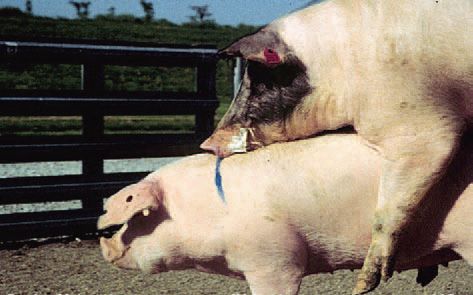
Physiology News Magazine
Learning to smell
The human olfactory system can ‘learn’ to smell androstenone. Why this should occur is uncertain and, because androstenone can have different smells to different people, it challenges the relationship between odour and receptors. There is perhaps more to this smelling business than meets the nose, says Tim Jacob
Features
Learning to smell
The human olfactory system can ‘learn’ to smell androstenone. Why this should occur is uncertain and, because androstenone can have different smells to different people, it challenges the relationship between odour and receptors. There is perhaps more to this smelling business than meets the nose, says Tim Jacob
Features
Tim Jacob
School of Biosciences, Cardiff University, Cardiff, UK
https://doi.org/10.36866/pn.56.18

There is a long-standing debate about how much, if any, of the olfactory system is hard-wired and therefore whether the discrimination of certain smells is innate or, alternatively, whether we have to learn to smell. This article concerns the phenomenon of induced sensitivity to the steroid androstenone which may give some insights into the process of acquisition of smell discrimination.
Androstenone is a member of the 16-androstene family of steroids, one source of which is the testes in pigs. The steroids gain access to the systemic circulation via the spermatic vein. In the salivary gland the steroids are stored and concentrated to be released into the saliva at moments of aggression or sexual activity. The response of the sow is to take up the mating position (‘lordosis’, Fig.1). Such a rapid response is typical of a releaser (or signalling) pheromone effect.

Cooks have long known that an unpleasant odour emanates from the meat of mature boar when it is cooked. This is the so-called ‘boar taint’ and one of the compounds responsible is 5α-androstenone.
Androstenone also occurs in human saliva, urine and sweat. It is found in much higher concentrations in men than women (Gower & Ruparelia, 1993).
A proportion of people (∼30%) cannot smell androstenone and those who can fall into two groups: a) a very sensitive group, who can detect less than 10 parts per trillion and who find the odour extremely unpleasant (urinous), and b) a group who are not only less sensitive but perceive the odour in different ways such as ‘sweet’, ‘musky’, ‘perfume-like’. The distribution of thresholds for androstenone, unlike most other odorants, is not normally distributed, but heavily skewed toward the high threshold end.
Androstenone is thought to be formed from non-odorous precursors (perhaps testosterone and progesterone) by the action of bacteria that inhabit the axillae (armpits). Since the type of microflora present will depend on the immune sensitivity of the individual this is one of the proposed mechanisms for how immunotype is related to an individual’s unique smell or ‘odortype’.
In the 1980s, Charles Wysocki, a smell researcher anosmic to androstenone, noticed in the course of an experiment involving the steroid what appeared to be induced sensitivity. After months of intermittent exposure he found that he could detect a distinct odour (Wysocki et al. 1989). He went on to study this phenomenon and found that subjects initially insensitive to androstenone could be induced to smell it by repetitive exposure. Subsequent studies have shown that even those who can smell it can lower their threshold by this treatment.
This phenomenon of sensitization to an odour is actually quite rare. Mostly repetitive exposure to odours leads to a decrease in responsiveness as the olfactory system adapts and/or habituates. Adaptation is a peripheral process and habituation is a central process, both involving an attenuation of the reponse to the repeated stimulus.
To date this sensitization phenomenon has only been shown to occur with androstenone in humans, and it occurs in both sexes. Women of reproductive age can become sensitized to benzaldehyde and citralva, something that does not happen to men or pre-pubertal or post-menopausal women. Another odorant commonly used in smell research is amyl acetate and it does not induce the same sensitivity increase (Dalton et al. 2002).
Initially, it was thought that the proportion of people that couldn’t smell androstenone had a ‘specific’ anosmia and were lacking the gene that coded for the receptor that bound androstenone. Examples of supposed specific anosmias have been reported; one person in 10 cannot smell the poisonous gas hydrogen cyanide and about one in 1,000 people are immune to the smell of skunk (butyl mercaptan). But the idea of specific anosmias has led people to underestimate the complexity of odour detection and discrimination. It is now known that there is not one receptor type for a given smell but that an odorous compound will activate a range of different receptors. These receptors and their respective glomeruli to which they project in the olfactory bulb are molecular ‘feature’ detectors. An odour is recognised because of the unique pattern of activation of these feature detectors – the odour code.
Recent work on the threshold for androstenone has shown that far fewer people than previously thought are really anosmic to it. When signal detection studies are performed, only between 2-6% of people seem to be unable to detect androstenone (Bremner et al. 2003). Detection thresholds are more similar among identical twins as compared to dizygotic twins; hence insensitivity to androstenone appears to have a genetic basis. One might expect it therefore to be stable over time. Early explanations put forward to explain the androstenone sensitization process invoked clonal expansion of the olfactory receptor cells containing the receptors for androstenone. An implication of this is that there must be a few cells that respond from which the expansion originates. This is difficult to reconcile with the notion of an odour code that requires the activation of many different receptors per odour. For example, one crucial receptor for the discrimination of androstenone might be missing, leading one to miscode it. But how, if that receptor is missing, is sensitivity induced? The only explanation that fits the facts is that there is a set of androstenone receptors, but they are expressed at such a low level that their activation does not result in perception. This argues against the existence of specific anosmias, at least for androstenone.
The search for specific anosmias was begun by John Amoore in an attempt to prove his ‘molecular shape theory’ of olfactory transduction. He believed that there were primary odours, much like the visual system, each with its own particularly shaped receptor. Odours fitted into one or more sites with varying affinities and the combination of binding gave rise to the multiplicity of smells that we can detect. Amoore thought that the known types of specific anosmias would represent the start of a list of primary odours (Amoore, 1967). But his definition of specific anosmia was arbitrary, a detection threshold greater than two standard deviations from the population mean. The ‘specific anosmics’ detected the odour, but at much higher concentrations.
How this phenomenon of induced sensitivity occurs is unclear. Yee and Wysocki (2001) provided evidence of the involvement of the olfactory epithelium by repetitively exposing mice with olfactory nerve transection to androstenone and demonstrating increased sensitivity (compared to pre-surgery levels) upon regrowth of the olfactory nerves. However, Mainland et al. in a recent study (2002) on humans in which they exposed only one nostril to repetitive stimulation and showed acquisition of sensitivity by the other, unexposed nostril, suggested that this learning occurred in central brain regions of the olfactory system.
We set out to monitor the response of the olfactory system during the acquisition of increased androstenone sensitivity by measuring the evoked potentials of the olfactory epithelium (EOGs), simultaneously with the event-related potentials (OERPs) recorded on the scalp using EEG electrodes. We correlated the results with the detection thresholds for androstenone. The EOG represents solely peripheral events, whereas the OERP reflects the activity of both peripheral and central elements of the olfactory system. It is thus possible to dissect out the location of any induced changes. We found that the androstenone-evoked EOG increased with increasing sensitivity and the OERP followed the EOG suggesting that this is a peripheral change occurring at the level of the olfactory receptors (Wang et al. 2004).
The fact that androstenone sensitivity can be induced or enhanced by exposure tends to militate against the current wisdom of the involvement of multiple receptors which ‘analyse’ the molecular features of androstenone (i.e. the odour code for androstenone), for one would have to postulate a concurrent increase in a number of different receptors or receptor cells, and rather suggests that a single receptor type or receptor cell is involved. Two plausible alternatives, those of rapid adaptation or central inhibition, were ruled out by our finding that if there is no sensitivity then there is no EOG.
Many questions remain: is there just one receptor for androstenone? Are new androstenone-sensitive olfactory receptor cells formed by clonal expansion of a small number of pre-existing receptor cells, or do existing cells express more androstenone receptors? Is just one population of cells stimulated to divide or make more receptors, or are all cells that detect androstenone’s molecular features stimulated to divide? Does this phenomenon extend to other steroids or, indeed, other compounds? What exactly is the significance of exposure-dependent smell learning? Once learned, is it reversible?
Further study of this phenomenon may answer some of these questions but, for the moment, androstenone-sensitization gives an indication of the kind of processes that might occur in babies as they learn to smell their new world and, most importantly, learn the smell of their own mothers – something they are able to do within 3 days of birth. A timescale that, coincidentally, is about the same as that taken for androstenone sensitization.
References
Amoore JE (1967). Specific anosmia: a clue to the olfactory code. Nature 214, 1095-1098.
Bremner EA, Mainland JD, KhanRM &Sobel N (2003). The prevalence of androstenone anosmia. Chem Senses 28, 423-432.
Dalton P, Doolittle N & Breslin PAS (2002). Gender-specific induction of enhanced sensitivity to odors. Nature Neuroscience 5, 199-202.
Gower DB & Ruparelia BA (1993). Olfaction in humans with special reference to odorous 16-androstenes: their occurrence, perception, possible social, psychological and sexual impact. J Endocrinol 137, 167-187.
Mainland JD, Bremner EA, Young N, Johnson BN, Khan RM, Bensafi M & Sobel N (2002). One nostril knows what the other learns. Nature 419, 802.
Wang L, Chen L & Jacob, TJC (2004). Evidence for peripheral plasticity in human odour response. J Physiol 554, 236-244.
Wysocki CJ, Dorries KM & Beauchamp GK (1989). Ability to perceive androstenone can be acquired by ostensibly anosmic people. Proc Natl Acad Sci USA 86, 7976-7978.
Yee KK & Wysocki CJ (2001). Odorant exposure increases olfactory sensitivity: olfactory epithelium is implicated. Physiol Behav 72, 705-711.
